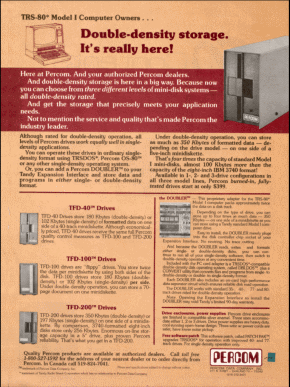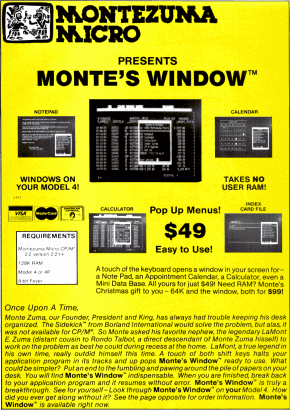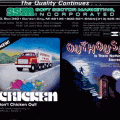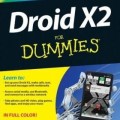An Interview with Jim Stutsman
I recently had the opportunity to interview Jim Stutsman, whose works include MICRODOS and DBLDOS for Percom and Monte’s Windows for Montezuma Micro. In the interview, conducted in October 2008, he had some very interesting answers to my questions and provided some fascinating insight into the early days of the TRS-80. See the interview below.

Jim Stutsman with his granddaughter
Photograph courtesy Jim Stutsman
Q: How did you get started with computers?
A: It’s winter of 1967 and I’m a sophomore at Michigan State University. I’m 3 credit hours short of full time, which means I could be drafted. All the classes I need for my major (Math) are full. I find “Computer Science 101” is open, for 3 hours, so I grab it. It turns out to be quite interesting, and I start to take more CPS classes, eventually declaring it my minor. By my Senior year I’m working part time as a programmer, so into it that I’m writing code in class instead of taking notes. This leads to me nearly failing Number Theory, the easiest of all math classes. To deal with the draft issue (this was the time of Viet Nam) I enrolled in ROTC, with promises that I might wind up in data processing. Eventually I learn that Army promises are not very reliable, and the Army learns that asthmatics aren’t all that reliable either. I got discharged on a medical and went to work in data processing. The irony is that my academic advisor talked me out of majoring in Computer Science on the grounds that it was new, and perhaps a flash in the pan. With only 13 CPS majors in a student body of 45,000, I couldn’t argue. He said “There will always be a need for mathematicians.” To this day I have yet to read a “Help Wanted” listing for a mathematician.
Q: How did you get started with the TRS-80?
A: In 1978 I built my first computer from a kit. It was based on the Motorola 6800 chip. At the 6800 User Group I met Harold Mauch of Percom Data. Hal was a fugitive from Texas Instruments, and had started his own company making a high-speed (120 bytes per second) tape interface for the S100 bus. He moved from that to a floppy disk drive. I owe Hal a great debt, as he convinced me to leave my job and write software for a living. When Tandy started offering floppy drives for the TRS-80, they used the same type of enclosure that Hal was using. They approached him to buy some covers, when their supplier couldn’t, and he had his covers painted Tandy silver. Eventually they wanted a lower price than he was happy with, leaving him with a lot of covers. Hal started selling drives. I bought a TRS-80, started hacking, and soon was writing software for it.
Q: Were MICRODOS and OS-80 the same product? If not, what was the difference between the two?
A: Both had a fairly short life, and to be honest I can barely remember. As best as I can recall, it was simply a renaming. There may have been a conflict with another company’s product using the MICRODOS name. It’s been too long, and a little too much water has gone under the bridge.
Q: MICRODOS was the only TRS-80 operating system not to be TRSDOS compatible. Why was this decision made?
A: We had already worked up a simple system for disk access on the 6800 systems, allowing direct sector access through Basic. It was a quick port to move this scheme to the TRS-80. TRSDOS compatibility would have required a great deal of reverse-engineering, and we wanted to get to market quickly.
Q: Did you work on any products other than MICRODOS at Percom?

Percom advertisement from November 1980
A: Yes. My first efforts were 6800-based, before the TRS-80 had hit its stride. This included a Basic interpreter and a BIOS for the Motorola 6809 chip. Shortly after MICRODOS I wrote a little application called VarKeep that allowed the variables from a BASIC program to be saved between runs. This was a kind of (really) primitive database. After TRSDOS and NEWDOS were in wide use, it was clear that double density would be a home run. Unfortunately the clock speed of the Z80 was not quite fast enough for TRSDOS to read double density data. The system used “polled” I/O, meaning that the program had to read a status byte, check for data, read it if available, and loop back if not. The problem came if a new data byte was read before the previous one was picked up, in which case data was lost. I figured out a way to make a different kind of loop that was fast enough to avoid data loss. This led to the Percom Doubler, the plug-in adapter that allowed the TRS-80 to read double density. Hal and engineer Wayne Smith, as talented a genius as Hal, worked out the hardware and I worked out the patches to the software.
Q: What work on the TRS-80 are you most proud of?
A: Without a doubt, the Doubler. I’m sure that anyone could have figured out the critical loop timing, but it was really cool to be first.
Q: What TRS-80 companies did you work for?
A: After the Doubler, Percom moved in a different direction, into accessories for the Atari. I was still working with the TRS-80, writing and selling applications. This led to Montezuma Micro, the first mail-order seller of TRS-80 computers. By then the Model IV was released, and Tandy was selling CP/M 2. This second version was different enough from the original CP/M that there was a fair bit of software that wouldn’t run with it. Montezuma had a license for the original CP/M, and needed a BIOS to implement it on the Model IV. I did the BIOS, and some utilities for CP/M. One of them was “Monte’s Window”, a CP/M program that duplicated the functions of Borland International’s “Sidekick” program for MS-DOS. It was one of the first “pop-up” utilities for the Model IV under CP/M.
Q: Do you have any stories about working at Percom?
A: I didn’t actually spend much time at Percom. Most of my coding was done at home, and I would drop in every few days to catch up with Hal. My most memorable story actually took place in San Francisco at the 4th West Coast Computer Faire. Hal had taken me along to help in his booth, selling drives for the TRS-80. A gentleman walked up to ask questions, and I spent several minutes talking with him. I’m proud of the fact that I kept my composure through the conversation, in spite of the fact that he was wearing a lovely orange and yellow tie-dyed dress. With a full beard, he was obviously not trying to live as a woman. Apparently he just liked wearing dresses. Of course I’d heard all about San Francisco, but this was my first “close encounter”.
Q: Do you have any stories about working at Montezuma Micro?

Montezuma Micro advertisement from January 1985
A: Oh, hundreds! Lots of very colorful folks worked there, and as my friend from Alabama used to say, “Every night was a Saturday night and every day was a Sunday.” One of the strange ones came about with the “Monte’s Window” pop-up utility. It had a built-in calendar, which you could set to any date. One of our users was a researcher in Papua, New Guinea. He sent us a letter pointing out that the calendar failed for dates prior to 1593, due to the change from the Julian to the Gregorian calendar in 1582. We went through several snail mail exchanges, as I sent updates by floppy. This was before the Internet, so it took more than a week for each message. I’m not sure which of us was the more obsessive-compulsive, him for testing it on such ancient dates, or me for spending the time to research and fix it. Proof yet again that programmers are not normal people!
Q: What was your impression of Radio Shack at the time?
A: They had a winner, but they didn’t seem to know what to do with it. The TRS-80 was so different from their usual range of products, but they never quite figured out how to market it. Even if IBM had never come out with the PC, I don’t think Tandy could have kept the TRS-80 going that much longer.
Q: What aspect of the TRS-80 world do you wish could be applied to computers today?
A: The only thing might be the simplicity. Back then we didn’t have to deal with virus infections, software updates, and complex operating systems. Of course we also couldn’t do a fraction of what we can now, and we had other annoying problems to deal with. One of the big annoyances was the connector on the Model 1 Expansion box, which was plated with tin. Cable connectors were all plated with gold, and this combination of metals with electricity caused rapid corrosion. Every TRS-80 owner had an eraser handy to clean the contacts when things stopped working.
Q: When did you last use a TRS-80?
A: I gave away my Model 1 in the early 80s, and sold the Model IV shortly after. By then I was heavily into PCs and the TRS-80 was fading fast.
Q: Do you ever look back on your TRS-80 experiences and if so, what is your overall opinion?
A: It was fun to be involved in the early stages of personal computing, and I’m very glad to have had the experience. One thing that I really regret is not getting to spend more time with Harold Mauch. He died in 1982, just 40 years old, from Leukemia. I’m sure he would have gone on to produce some really great products, and I would have liked to have been a part of it.
Q: What have you been doing since your days working with the TRS-80?
A: It’s been an interesting ride. I spent a number of years writing software on a freelance basis. In 1987 my wife opened a sewing machine dealership in Carrollton, Texas. By 1992 it had grown to the point that it required more than one person, and I was getting a little tired of computer work. I joined her full time. Now 16 years later, I’m still there. I still write a little software, mostly applications for the business. I did do one commercial product specific to the machines we sell, and it did pretty well. In 1997 I made the transition from PC to Mac, and I’m never going back. For applications that must run under Windows I used VMware Fusion to run virtual Windows machines. When time permits, I hope to get up to speed with Cocoa on the Mac so I can develop applications for both it and the iPhone. Our website is www.sewingroom.com.
My thanks to Jim Stutsman for his participation in this interview.














Miguel Dutra says:
Very pleasant reading. At the same time, it leaves an uncomfortable feeling of nostalgia for the good times already gone.
Miguel.
Stan Feldman says:
Owner of the largest trs-80 software mail order company DiskCount Data. You have a great site and I may have contacted you several years ago. I have a unique perspective on the TRS-80 and we made a very decent living providing software for it for several years. I have personally known many of the TRS-80 world “insiders” over the years and have many fond memories That I would like to memorialize one day. Characters such as Jim Stutsman, John Lancione of Montezuma Micro and Aerocomp, Denis Brent of Powersoft, Kim Watt of Superutility fame (Dennis and Kim were originally partners of mine prior to me owning Diskcount Data). Harv Pennington who we acquired Electric Pencil from and formed Electric Software Corporation. Bill Schroeder (LDOS) and many other true characters. I also have probably the premier collection of TRS-80’s, software and books. I bought over 1,000 sets of the TRS-80 Encyclopidea both in hard and soft cover from the publisher and sold them all thru DiskCount Data. We continued to advertise and ship TRS-80 aftermarket products long after 80-Micro went belly up.
Keep up the good work. The trs-80 was a very important part of the microcomputer evolution and no one can refute the history of the “early days”
Stan Feldman
Dan Griz Pollock says:
Wow Feldman and Stutz on the same page :) I used to work with these guys many moons ago.